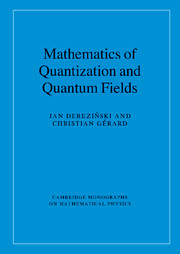Book contents
- Frontmatter
- Contents
- Introduction
- 1 Vector spaces
- 2 Operators in Hilbert spaces
- 3 Tensor algebras
- 4 Analysisin L2 (ℝd)
- 5 Measures
- 6 Algebras
- 7 Anti-symmetric calculus
- 8 Canonical commutation relations
- 9 CCR on Fock space
- 10 Symplectic invariance of CCR in finite-dimensions
- 11 Symplectic invariance of the CCR on Fock spaces
- 12 Canonical anti-commutation relations
- 13 CAR on Fock spaces
- 14 Orthogonal invariance of CAR algebras
- 15 Clifford relations
- 16 Orthogonal invariance of the CAR on Fock spaces
- 17 Quasi-free states
- 18 Dynamics of quantum fields
- 19 Quantum fields on space-time
- 20 Diagrammatics
- 21 Euclidean approach for bosons
- 22 Interacting bosonic fields
- References
- Symbols index
- Subject index
12 - Canonical anti-commutation relations
- Frontmatter
- Contents
- Introduction
- 1 Vector spaces
- 2 Operators in Hilbert spaces
- 3 Tensor algebras
- 4 Analysisin L2 (ℝd)
- 5 Measures
- 6 Algebras
- 7 Anti-symmetric calculus
- 8 Canonical commutation relations
- 9 CCR on Fock space
- 10 Symplectic invariance of CCR in finite-dimensions
- 11 Symplectic invariance of the CCR on Fock spaces
- 12 Canonical anti-commutation relations
- 13 CAR on Fock spaces
- 14 Orthogonal invariance of CAR algebras
- 15 Clifford relations
- 16 Orthogonal invariance of the CAR on Fock spaces
- 17 Quasi-free states
- 18 Dynamics of quantum fields
- 19 Quantum fields on space-time
- 20 Diagrammatics
- 21 Euclidean approach for bosons
- 22 Interacting bosonic fields
- References
- Symbols index
- Subject index
Summary
Throughout this chapter, (Y, ν) is a Euclidean space, that is, a real vector space Y equipped with a positive definite form ν.
In this chapter we introduce the concept of representations of the canonical anti-commutation relations (CAR representations). The definition that we use is very similar to the definition of a representation of the Clifford relations, which will be discussed in Chap. 15. In the case of CAR representations we assume in addition that operators satisfying the Clifford relations act on a Hilbert space and are self-adjoint, whereas in the standard definition of Clifford relations the self-adjointness is not required.
CAR representations are used in quantum physics to describe fermions. Actually, CAR representations, as introduced in Def. 12.1, are appropriate for the so-called neutral fermions. Most fermions in physics are charged, and for them a slightly different formalism is used, which we introduce under the name charged CAR representations. Charged CAR representations can be viewed as a special case of (neutral) CAR representations, where the dual phase space Y is complex and a somewhat different notation is used.
CAR representations appear in quantum physics in at least two contexts. First, they describe fermionic systems. This is to us the primary meaning of the CAR, and most of our motivation and terminology is derived from it. Second, they describe spinors, that is, representations of the Spin and Pin groups. In most applications the second meaning is restricted to the finite-dimensional case. We will also discuss the second meaning (including the Spin and Pin groups over infinite-dimensional spaces).
- Type
- Chapter
- Information
- Mathematics of Quantization and Quantum Fields , pp. 313 - 336Publisher: Cambridge University PressPrint publication year: 2013



